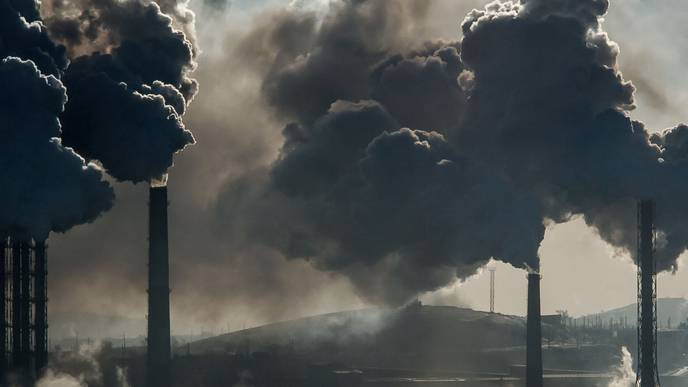ReachMD
Be part of the knowledge.™Health Burden of Air Pollution Differs Across Racial Groups

Health benefits that have resulted from reductions in fine particulate air pollution aren’t distributed equally among populations in the U.S., a new Yale-led study finds. Racial and ethnic minorities — and Black people in particular — still experience disproportionately high rates of cardiovascular disease-related deaths caused by exposure to fine particulate matter, according to the research.
The findings were published Aug. 31 in Nature Human Behavior.
Fine particulate matter, also known as PM2.5, consists of particles or droplets smaller than 2.5 micrometers in diameter, or 30 times smaller than the width of a human hair. While some PM2.5 in the environment comes from natural sources, such as wildfires, the majority of particulate matter pollution in the U.S. is the result of human activities, including emissions from vehicles, power plants, and factories.
The small size makes PM2.5 harmful for human health, said Kai Chen, assistant professor of epidemiology at Yale School of Public Health and senior author of the study.
“When you inhale such small particles, they can get into your lungs and some smaller particles can even get into the blood stream and circulate around the body,” said Chen. “That can impact your heart, which leads to a lot of the cardiovascular disease we see today.”
Environmental efforts including the 1963 Clean Air Act and the Environmental Protection Agency’s (EPA) National Ambient Air Quality Standards for PM2.5, established in 1997, have helped bring down PM2.5 levels throughout the United States. This, in turn, has yielded benefits to human health. But it has remained unclear whether these health benefits are distributed equitably across racial and ethnic groups.
“We know that some minorities, especially Black and Hispanic people, are exposed to higher levels of PM2.5 than white people,” said Chen. “In our study, we wanted to go further and assess vulnerability to PM2.5 across different groups and see how that relates to mortality.”
For the study, the researchers collected data on cardiovascular disease deaths and monthly PM2.5 concentrations across 3,103 counties in the contiguous U.S. between 2001 and 2016. They then evaluated whether there was a link between increases in PM2.5 levels and changes in cardiovascular disease-related deaths.
Overall, an increase of one microgram per square meter in average PM2.5 levels was associated with 2.01 additional cardiovascular disease-related deaths per 1 million people. But when the researchers took a closer look at the data, they found that the human costs vary in different populations: the same increase in the average PM2.5 levels was associated with 1.76 additional deaths per 1 million white people, 2.66 additional deaths per 1 million Hispanic people, and 7.16 additional deaths per 1 million Black people.
The researchers also assessed mortality burden across race and ethnicity, evaluating the number of cardiovascular disease-related deaths that were attributable to long-term PM2.5 exposure between 20o1 and 2016. On average, there were 202.70 deaths per 1 million white people, 279.24 deaths per 1 million Hispanic people, and 905.68 deaths per 1 million Black people each year.
“Black people experience the highest burden when it comes to mortality rate,” said Chen.
To determine whether mortality burden changed over time, the researchers then compared mortality rates between 2001 and 2016. In total, cardiovascular disease-related deaths attributable to long-term PM2.5 exposure decreased by more than 34% over that time period. And rates decreased within white, Hispanic, and Black populations.
However, the ratio of mortality rates between white and Hispanic people and between white and Black people hardly changed between 2001 and 2016. Mortality rates for Hispanic people were 1.37 times higher than white people in 2001, increasing to 1.45 times higher by 2016. Mortality rates for Black people were 4.59 times higher than white people in 2001 and 4.47 times higher in 2016.
“Air pollution reduced and that reduced exposure for everyone, which is very good news,” said Chen. “But Black people still experience a higher burden because they are more vulnerable and at higher risk of mortality.”
The findings, he says, underscore that the public health burden of air pollution differs across racial groups and that should help inform policy design going forward. The EPA, U.S. lawmakers, and local governments should consider not just the overall population as they develop policies to improve air quality, but also high-vulnerability groups in particular.
“Poor air quality imposes a substantial burden on Black Americans, with greater exposures and greater vulnerability,” said coauthor Harlan Krumholz, the Harold H. Hines, Jr. Professor of Medicine at Yale School of Medicine. “We have identified another way that the structure of our society contributes to cardiovascular health disparities. The study demonstrates that the excess mortality among Black people is not just derived from traditional risk factors, but likely also to the increased exposure to poor air quality based on where they live.”
Chen will continue to investigate this health burden disparity in a new project funded by a Yale Planetary Solutions Project seed grant. He and his colleagues will assess PM2.5 exposure, cardiovascular disease risk, and morbidity burden at the neighborhood level and design location-specific strategies to address inequalities.
Facebook Comments